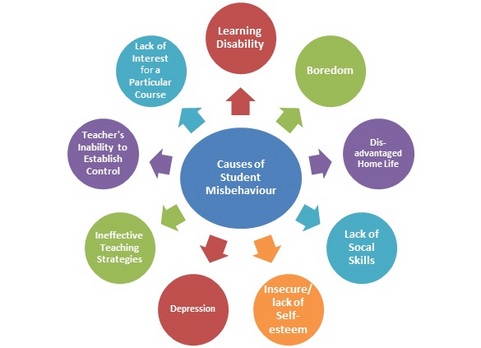Diversities Behind Behaviour
Causes of Student Misbehaviour

© Naomi McCoombes 2011.
This diagram respresents elements of student mis-behaviour in the classroom. More often than not, what we as educators present to them as learning can result in a lack of control within the classroom. If they aren't engaged, kept busy, their learning abilities considered and their styles of learning appealed to, students can and will react negatively toward what we are trying to achieve.
Consider a student with Dyslexia. Assume the teacher sets out a lesson involving chalk and talk. Suppose students are expected to spend 10 mins of the lesson listening and copying from the board. A student with Dyslexia is not going to be able to learn this way for a number of reasons:
Ø Complications with sight words
Ø Limited comprehension when reading
Ø Phonetic and incompatible spelling
Ø Difficulty reading
Ø Believes to have movement of text when reading, writing or copying
Ø Confusion with letters, words, sequencing, numbers or verbal explanations
(McCoombes, N. 2011, p.3)
Let’s consider the educator doesn’t factor in this student’s learning disability and goes forth with the strategy in question. The following options can most likely arise as a result:
Ø Student feels reclused
Ø He/she finds the activity pointless and give up learning
Ø Boredom sets in
Ø They start to use that time to entertain/disrupt others
Ø Disrupts the classroom dynamic
Ø Become energised as a result of the control they now sustain.
Suddenly the entire class is now focused on one student’s attitude as a result of a lesson that never “included” them to begin with. Evidently diversity in the classroom must be considered and accounted for in terms of achieving successful behaviour management. The important thing to remember is each lesson requires their chance to learn equally with their peers. Inclusion is what defines a successful teaching environment in terms of diversity.
Students need support physically, psychologically, emotionally and socially. All these aspects affect their cognitive development and manipulate behavioural outcomes. Teaching strategies are there to provide this support together with understanding the needs of these students.
Ø Complications with sight words
Ø Limited comprehension when reading
Ø Phonetic and incompatible spelling
Ø Difficulty reading
Ø Believes to have movement of text when reading, writing or copying
Ø Confusion with letters, words, sequencing, numbers or verbal explanations
(McCoombes, N. 2011, p.3)
Let’s consider the educator doesn’t factor in this student’s learning disability and goes forth with the strategy in question. The following options can most likely arise as a result:
Ø Student feels reclused
Ø He/she finds the activity pointless and give up learning
Ø Boredom sets in
Ø They start to use that time to entertain/disrupt others
Ø Disrupts the classroom dynamic
Ø Become energised as a result of the control they now sustain.
Suddenly the entire class is now focused on one student’s attitude as a result of a lesson that never “included” them to begin with. Evidently diversity in the classroom must be considered and accounted for in terms of achieving successful behaviour management. The important thing to remember is each lesson requires their chance to learn equally with their peers. Inclusion is what defines a successful teaching environment in terms of diversity.
Students need support physically, psychologically, emotionally and socially. All these aspects affect their cognitive development and manipulate behavioural outcomes. Teaching strategies are there to provide this support together with understanding the needs of these students.
